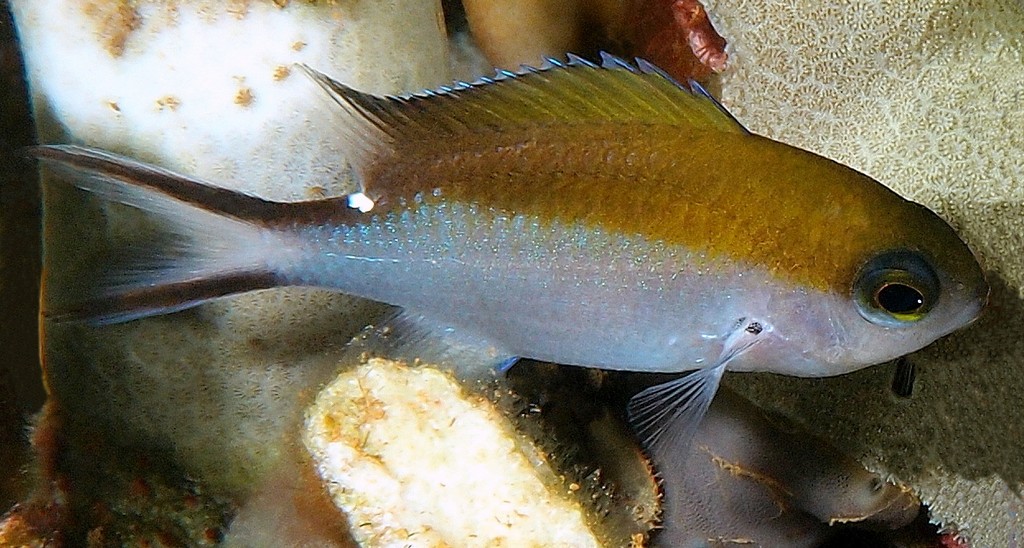CHROMIS NORFOLKENSIS - (ALLEN & ALLEN, 2021)
Actinopterygii (Gigaclass) > Actinopteri (Class) > Teleostei (Subclass) > Blenniiformes (Order) > Pomacentridae (Family) > Chrominae (Subfamily) > Chromis (Genus)
Norfolk Chromis,
Description
Dorsal spines (total): 13-14 (usually: 13) ; Dorsal soft rays: 12-13 (usually: 12); Anal spines: 2; Anal soft rays: 10-11 (usually: 10); Dorsal- and anal-fin soft rays branched, except first dorsal-fin ray usually unbranched and first anal-fin ray occasionally unbranched, last rays branched to base; Pectoral-fin rays: 18-20 (usually: 19), uppermost and lowermost pairs unbranched; Pelvic-fin rays: I, 5; Principal caudal-fin rays: 15, uppermost and lowermost unbranched; Spiniform caudal-fin rays: 2, followed by two accessory segmented rays; Scales in longitudinal series 27; Tubed lateral-line scales: 17-19; Total gill rakers on first branchial arch: 30-34 (usually: 31-33); Body depth: 2.0-2.4 (mean: 2.2) in SL; Mouth terminal, small, and oblique, forming an angle of about 40° to horizontal axis of head and body; posterior edge of maxilla reaching a vertical about level with anterior edge of pupil. Opercle ending posteriorly in a flat spine, tip relatively obtuse and obscured by a large scale; Margin of preopercle with about: 20 (20-41) tiny serrae, posterior margin extending dorsally to level of upper edge of pupil, ventral margin extending anteriorly to level of middle of pupil; Lower margin of suborbital hidden by scales. Scales finely ctenoid; Tubed lateral-line scales ending beneath base of first two soft rays of dorsal fin; head scaled except lips, tip of snout, and a narrow zone from front of orbit to edge of snout containing nostril; a scaly sheath at base of dorsal and anal fins, up to about one-half pupil diameter in width at base of posterior dorsal-fin spines, progressively narrower on soft portion; A column of scales on each membrane of dorsal and anal fins, narrowing distally, those on spinous portion of dorsal progressively longer, reaching about two-thirds to three-fourths distance to spine tips on posterior membranes, then progressively shorter on soft portion; small scales broadly covering caudal-fin lobes; Small scales on fleshy base of pectoral fins, extending onto basal part of rayed portion; a median scaly process extending posteriorly from between base of pelvic fins, length 35-60% that of pelvic spine; Axillary scale above base of pelvic spine 48-55% length of spine. Max. length: 8.4 cm SL. Depth range: 5 - 40 m.
Color
Adult dark to light brown or yellowish on upper half and white on lower half, transition between two halves more or less abrupt with slightly diagonal demarcation extending from lower rear corner of eye to conspicuous small, rounded, white spot, half pupil size or less, at base of last dorsal-fin rays; Dorsal fin brown grading to nearly black distally, darkest on outer two-thirds of anterior half of soft portion of fin, remainder of fin plain translucent and outer margin of entire dorsal fin narrowly pale blue to bluish white; Anal and pelvic fins white with narrow, bluish, anterior margin; Caudal fin translucent whitish to bluish with broad black bands along upper and lower margins with a narrow blue-white edge; Pectoral fins translucent with a black patch covering outer portion (fin side) of axil, slightly encroaching on dorsal edge of fin base.
Etymology
Chromis: from Greek, chroemo = to neigh. A name dating to Aristotle, referring to a drum (Sciaenidae) and its ability to make noise; Later applied to this damselfish and subsequently expanded to embrace dottybacks, cichlids and wrasses (all perch-like fishes once thought to be related).
norfolkensis: named for the type locality, Norfolk Island in the southwestern Pacific Ocean.
Original description: Chromis norfolkensis Allen & Allen, 2021 - Type locality: Australia, Norfolk Island, Duncombe Bay, -28.999°, 167.929°, 18 m, spear, J. E. Randall, 21 November 1989.
Distribution
From the northern Tasman Sea and southern Coral Sea region at northern New Zealand, Norfolk Island, New Caledonia, and the Chesterfield Islands. It has also been photographed at New South Wales, Australia in the vicinity of Sydney and Swansea (Kuiter 1993).
Chromis: from Greek, chroemo = to neigh. A name dating to Aristotle, referring to a drum (Sciaenidae) and its ability to make noise; Later applied to this damselfish and subsequently expanded to embrace dottybacks, cichlids and wrasses (all perch-like fishes once thought to be related).
norfolkensis: named for the type locality, Norfolk Island in the southwestern Pacific Ocean.
Original description: Chromis norfolkensis Allen & Allen, 2021 - Type locality: Australia, Norfolk Island, Duncombe Bay, -28.999°, 167.929°, 18 m, spear, J. E. Randall, 21 November 1989.
Distribution
From the northern Tasman Sea and southern Coral Sea region at northern New Zealand, Norfolk Island, New Caledonia, and the Chesterfield Islands. It has also been photographed at New South Wales, Australia in the vicinity of Sydney and Swansea (Kuiter 1993).
Biology
Found on outer reef slopes around boulders or occasionally on coral patch reefs.
Similar species
- Chromis fumea (Tanaka, 1917) - Reported from Japan to the Ryukyu Islands, and southwards to Taiwan.
- Chromis nitida (Whitley, 1928) - Reported from Southwestern Pacific: central Great Barrier Reef (Queensland, Australia) south to Sydney (New South Wales, Australia), including Lord Howe Island (Australia).
- Chromis notata (Temminck & Schlegel, 1843) - Reported from Western Pacific: northern Vietnam, southern China and Taiwan north to Korea, Japan and Ogasawara Islands.
- Chromis sahulensis (Allen & Allen, 2021) - Reported from northwestern Australia.
- Chromis westaustralis (Allen, 1976) - Reported from Eastern Indian Ocean: Western Australia and Northern Territory (Australia).
Last update: 7, November 2021
